Anatomy of the Female Pelvic Floor
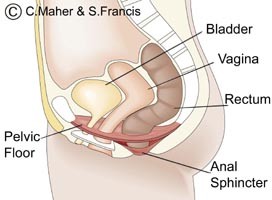
The female pelvic floor serves to aid in the function of the lower urinary system, genital tract and rectum. The majority of the time the muscles are contracted and aid in urinary and fecal continence, and support of the genital tract. Relaxation of these muscles occurs at urination, defecation, coitus and childbirth. The female pelvic floor is composed of voluntary muscle, fascia and condensations of fascia called ligaments that all work together to offer support and function to the organs that exit through the female pelvis.
The relationship of the pelvic floor and the organs exiting the pelvis is shown above. In the following series of diagrams I hope to build up the complete pelvic floor so that you can understand the anatomical relationship of the muscles, fascia, ligaments and organs of the female pelvic floor.
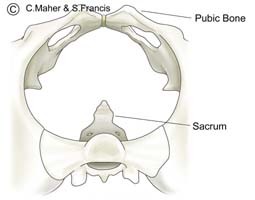
Diagram 1 illustrates an empty pelvis looking from above. At the back is the sacrum (tailbone) and the front is the pubic bones.
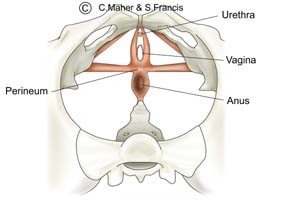
Exiting the female pelvis from the front to the back, is the urethra, vagina and anus. The anus is surrounded by the anal sphincter which is connected to the sacrum behind and the perineum muscles in front. An intact and functioning anal sphincter is important in maintaining faecal continence.
The perineum stabilizes the lower pelvic floor. The perineum is stabilized to the pelvic side-wall by the transverse perineal muscles.
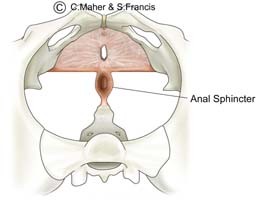
The urogenital diaphram offers further support to the lower urethra and vagina and is stabilized to the pubic bones and the perineum.
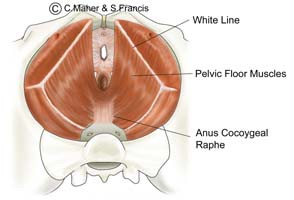
The pelvic floor muscles form a sling around the lower pelvic outlet and when contracted offers support to the lower bowel, the genital tract and the lower urinary tract. These muscles arise from the white line (arcus tendineous fascia pelvis) on lateral pelvic side-wall and interdigitate with each other and the anococcygeal raphe in the centre.
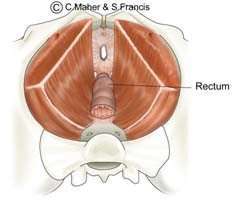
The rectum lies on the pelvic floor and joins to the anus as it passes through the pelvic floor. When the pelvic floor muscles are contracted the anorectal junction is pulled forward. At defecation the muscle relaxes and allows faeces to enter the anus for emptying.
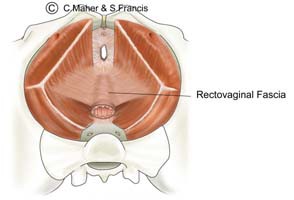
The rectum is stopped from bulging forward into the vagina by the rectovaginal fascia. This runs at right angles to the pelvic floor muscles and gains support laterally from the pelvic floor muscles.
Women with rectoceles (rectum bulging forward into the vagina) have defects in this fascia. This is what is repaired in women with posterior vaginal wall prolapse.
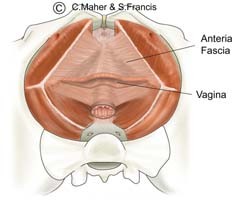
The mid-vagina rest on the rectovaginal fascia and is separated from the bladder and urethra by the anterior vaginal wall fascia (pubocervical).
Women with cystoceles (bladder prolapse) have a defect in this fascia. This fascia is plicated in anterior vaginal repairs and elevated in paravaginal and colposuspension procedures.
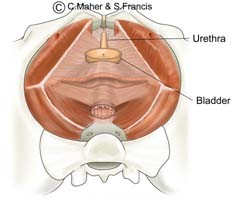
The bladder and urethra are separated from the vagina by the pubocervical fascia. Intact fascia stops the bladder from bulging down into the vagina.
Women with a cystocele have a defect or weakness in this fascia. In women with stress urinary incontinence the fascia is weak resulting a lack of support for upper urethra.
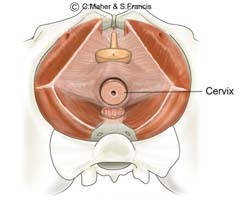
The top of the fascia on the anterior and posterior vaginal wall connect with cervix at the top of the vagina. The cervix is the very firm lower portion of the uterus and acts to stabilise the fascia of the female pelvis.
The cervix is the cornerstone of the upper female pelvic floor just as the perineum is central to the support of the lower pelvic floor.

The cervix is supported to the lateral pelvic side-wall by the strong cardinal ligaments.
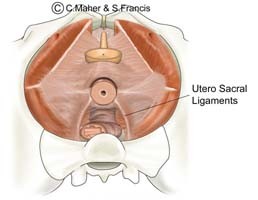
The cervix is also supported by the strong uterosacral ligaments that run from the sacrum (tailbone) to the cervix. Women with upper vaginal prolapse (uterine prolapse, vault prolapse or enteroceles) have defects in the uterosacral and / or cardinal ligaments that allows the prolapse to occur.

The uterus, ovaries and fallopian tubes are added to complete the picture.
The distended bladder is shown.
Women with upper vaginal prolapse have a defect of the cardinal and uterosacral ligaments.
Cystoceles are due to weakness of the pubocervical fascia. Urinary stress incontinence is due to a lack of support by the fascia and pelvic floor muscles to the upper urethra. Rectoceles are due to tears or weakness of the rectovaginal fascia. The cervix and perineum are the centre points for stabilization of the pelvic floor.